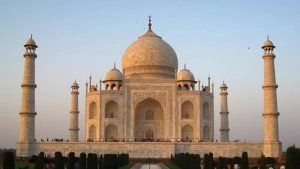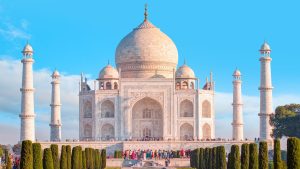The Taj Mahal, India’s most iconic monument and a symbol of eternal love, has shown signs of structural distress due to the recent relentless monsoon rains. The discovery of cracks on its walls and floors, alongside reports of plants growing out of crevices, has alarmed preservationists and tourists alike. Videos and images of the damage, shared across various platforms, have triggered concerns about the potential long-term effects of weather and environmental factors on this UNESCO World Heritage Site.
The Extent of the Damage

Reports surfaced on September 20, 2024, confirming that multiple cracks had formed on the structure after heavy rains lashed the city of Agra. These cracks were found on several significant parts of the monument, including its walls and the intricate marble flooring, which has been the subject of intense preservation efforts over the years.
In one particularly alarming case, videos circulating online showed a small plant sprouting from the cracks, further raising concerns about the structural integrity of the monument. This is especially worrying as the Taj Mahal is already subjected to ongoing preservation work due to the impact of pollution and environmental degradation over time. The presence of plant growth indicates that moisture and small cracks have been infiltrating the monument’s marble facade for a while, providing the conditions for biological growth.
Authorities Respond
The Archaeological Survey of India (ASI), the primary agency responsible for the preservation of historical monuments, quickly addressed these concerns. Rajkumar Patel, the Superintendent of ASI’s Agra Circle, downplayed the situation somewhat, stating that the growth of plants on heritage monuments is not entirely unusual. He explained that plant growth on cracks and corners is typically removed using root killers and pesticides, a process that usually takes around eight to ten days.
However, while the ASI has taken steps to reassure the public that the situation is under control, experts worry about the compounding effects of various environmental stressors on the Taj Mahal. Agra’s climate, which alternates between intense summer heat and heavy monsoon rains, combined with the constant threat of pollution from industrial activities nearby, makes the monument vulnerable to rapid deterioration if timely interventions are not made.
Ongoing Preservation Efforts

The Taj Mahal, which was completed in 1648 by Mughal Emperor Shah Jahan in memory of his wife Mumtaz Mahal, has been subject to numerous restoration efforts over the years. The white marble structure has suffered significant damage from air pollution, particularly sulfur dioxide from nearby factories, which causes a yellowing effect on the marble surface. Authorities have taken measures to curb pollution in the vicinity, including banning vehicular traffic within a certain radius of the monument and enforcing stricter industrial regulations. Despite these efforts, the monument remains at risk from environmental factors, as seen in the latest incident.
In recent years, the use of a “mudpack” treatment has been employed to restore the Taj Mahal’s original luster. This process involves applying a special type of clay to the marble surface, which absorbs dirt and pollutants before being washed off. This technique is akin to a facial treatment for the monument, and it has been used multiple times to counteract the effects of pollution.
However, this latest incident suggests that the challenges faced by the Taj Mahal are not solely external. Structural integrity is increasingly becoming a concern, particularly as the monument continues to age.
Environmental Impact and Public Concern

Agra has experienced increasingly erratic weather patterns, with this year’s monsoon season being particularly intense. The heavy rainfall has not only caused widespread flooding in the region but also seems to have exacerbated the vulnerabilities of the Taj Mahal. Experts believe that constant exposure to moisture can weaken the foundation of historical monuments, especially those made of materials like marble, which are prone to weathering.
The cracks that have emerged in the Taj Mahal after this year’s monsoon rains are a reminder of the constant balancing act involved in preserving such an ancient and delicate structure. Furthermore, the fact that plants are growing in the cracks hints at the ongoing battle between nature and human efforts to keep the monument intact.
Tourists and local residents have expressed their concern over the damage, with many calling for immediate action. Given the Taj Mahal’s status as one of the most visited tourist destinations in the world, any signs of structural damage are likely to have far-reaching implications, not just for heritage preservation but also for tourism—a key contributor to Agra’s economy.
Looking Ahead: The Future of the Taj Mahal

The recent cracks on the Taj Mahal serve as a stark reminder that even the most beautiful and carefully preserved monuments are vulnerable to the forces of nature. While the ASI has assured the public that measures will be taken to repair the damage, long-term preservation strategies must be continuously updated to account for environmental changes, such as shifting weather patterns and pollution.
Experts suggest that more frequent inspections, the use of advanced technology in preservation, and enhanced environmental regulations around the monument are crucial for ensuring that future generations can continue to admire the Taj Mahal in its full glory.
The incident underscores the importance of sustained and vigilant preservation efforts for historical monuments, especially those exposed to the elements. For now, while immediate concerns about the Taj Mahal’s cracks may be addressed by the ASI’s routine measures, the monument’s ongoing struggle against environmental damage remains a pressing issue for India’s heritage conservation efforts.
YOU MAY ALSO READ: Highlights of BJP 2024 Haryana Manifesto: Jobs, Women’s Welfare, and Infrastructure Top Priorities








